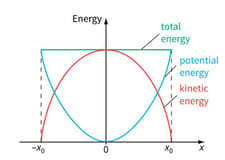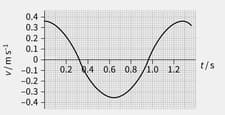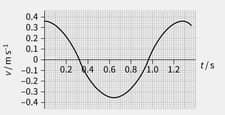Figure shows how the different forms of energy change with displacement during s.h.m. Copy the graph, and show how the graph would differ if the oscillating mass were given only half the initial input of energy.



Important Questions on Oscillations
Figure shows how the velocity of a mass was found to vary with time during an investigation of the s.h.m. of a pendulum. Use the graph to estimate the following for the mass: Its maximum velocity

Figure shows how the velocity of a mass was found to vary with time during an investigation of the s.h.m. of a pendulum. Use the graph to estimate the following for the mass: Its maximum kinetic energy.

Figure shows how the velocity of a mass was found to vary with time during an investigation of the s.h.m. of a pendulum. Use the graph to estimate the following for the mass: Its maximum potential energy

Figure shows how the velocity of a mass was found to vary with time during an investigation of the s.h.m. of a pendulum. Use the graph to estimate the following for the mass: Its maximum acceleration

Figure shows how the velocity of a mass was found to vary with time during an investigation of the s.h.m. of a pendulum. Use the graph to estimate the following for the mass: The maximum restoring force that acted on it.

Sketch graphs to show how each of the following quantities changes during the course of a single complete oscillation of an undamped pendulum: kinetic energy, potential energy, total energy.
List three examples of situations where resonance is a problem, and three others where resonance is useful. In each case, state what the oscillating system is and what forces it to resonate.
